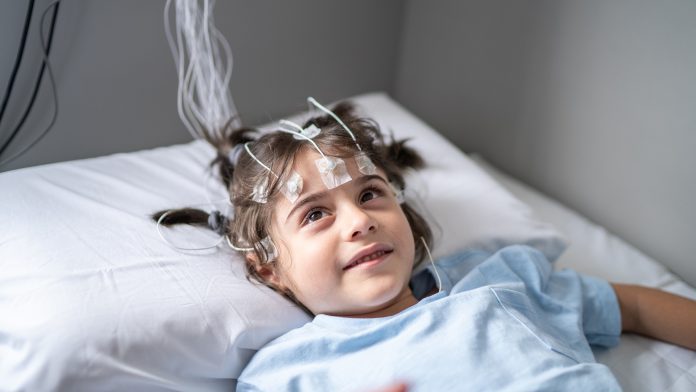
A new study looks at how sleep EEGs in patients with Rett syndrome could aid in predicting disease features and severity.
Rett syndrome is a genetic condition affecting mostly girls; mutations in the MECP2 gene cause regression of language and motor skills starting at 12 to 18 months of age. Impacted children usually stabilise; however, it is difficult to predict how Rett syndrome will affect them in the future. It can lead to epilepsy, language, cognitive, and fine motor function problems.
The pilot study, led by Patrick Davis, MD, PhD, a resident in the Department of Neurology at Boston Children’s Hospital and April Levin MD, a faculty researcher and neurologist, suggests that overnight EEG studies can help clinicians with what to expect and inform care for Rett syndrome.
“There is a huge range of symptom severity in Rett syndrome,” said Davis. “For example, language development can range from relatively normal to being able to have simple conversations to having no words and no language comprehension. We currently have no reliable way to predict, much less modify, this developmental trajectory. A biomarker would be a step toward developing more refined interventions.”
Monitoring patients with Rett syndrome during the night
EEG studies have already been implemented for Rett syndrome but are typically carried out when the child is awake. The researchers wanted to discover if anything would happen to the EEG during sleep.
“Sleep is an active time when the brain processes new information and rewires to optimise its functioning,” commented Davis. “We reasoned that altered brain activity in sleep might contribute to neurodevelopmental problems in Rett syndrome. There’s a rich literature on sleep EEGs, but few studies have looked at Rett syndrome specifically.”
The study analysed overnight EEG data from 22 girls with Rett syndrome ordered by clinicians (most likely to evaluate seizures) and 25 age-matched, typically developing controls. The researchers tracked the different frequency waves that make up the EEG signal, each created by the collective firing of large groups of neurons.
The team focused on phase-amplitude coupling, a measure of how slow EEG oscillations, which are crucial for memory consolidation, relate to higher-frequency waves. This relationship has shown how well brain activity is integrated.
This stage showcases how children with the syndrome and unaffected children develop differently.
Unaffected children exhibit the close coupling of slow and fast oscillations at the top of the brain, starting at around 12 to 18 months of age. However, children with Rett syndrome did not develop that feature and had different patterns of coupling of slow and fast oscillations in various brain locations.
“Just by looking at the sleep EEG, we could predict whether a patient had Rett syndrome or not with 90% accuracy,” said Davis. “We also found specific EEG patterns that may correspond to different subtypes of Rett syndrome or even help predict clinical severity.”
Using EEGs for early-onset sleep disorders
Davis emphasises that this work is just a first pass in a small, select group of patients that need to be confirmed and expanded upon. The researcher noted that altered EEG patterns are not a proven cause of neurodevelopmental regression in Rett syndrome but could open new possibilities.
“If we can validate our findings in a larger cohort of girls with Rett, it would be interesting to see if doing non-invasive brain stimulation at night — with a cap worn during sleep — could improve some EEG biomarkers, and whether targeted brain stimulation would improve a child’s developmental trajectory,” he said. “That is one of our ultimate goals.”
Transcranial magnetic stimulation (TMS) is used in children with epilepsy and has proven to be safe. This therapy could offer an alternative to epilepsy or sleep medications, which can come with side effects or be utilised with other drugs. Further EEG studies in girls with Rett syndrome could point to particular brain circuits to target stimulation.
Davis and his research team are planning to look at overnight EEGs in children with the syndrome who don’t have epilepsy and in children with other early-onset disorders that involve altered sleep dynamics, such as epileptic encephalopathies, infantile spasms, trisomy 21, and autism spectrum disorder.
“The development of reliable biomarkers is a key step towards identifying the best anti-seizure medications and developing pharmacologic treatments for the cognitive and intellectual symptoms for these disorders,” Davis concluded. “We think overnight EEGs could be the foundation of meaningful translational work.”






















